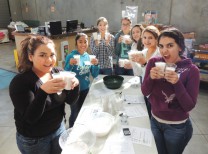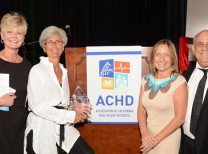“I developed allergies after moving to the desert” is a common sentiment which I shared. Or so I thought.
Shortly after my arrival from Northern California, I developed this chronic phlegm in the back of my throat. Claritin seemed to help, so I thought it was safe to assume that I had developed a seasonal allergy to something in my new environment. However, the condition persisted, and I often awoke choking and coughing uncontrollably because of the post nasal drip.
Determined to get rid of the on-going symptoms – and to the root of the cause – I began a four-year journey into both the medical and naturopathic realms for diagnosis and treatment.
What is the cause of this desert phlegm so many of us experience?
In looking back on my documented journey for this article, I decided to get further insight from board certified otolaryngologist (ear, nose and throat doctor), Maya Kato, MD, of The Ear Institute in Palm Desert. She confirmed that allergies are far more common in the desert than in other regions due to our golf courses, plants, dust and wind. But allergies are not the only cause of these symptoms, and diagnosis and treatment will vary from doctor to doctor.
“When someone presents with ‘a frog in their throat,’ the first thing we try to determine is if it is coming from the top down (from sinuses) or up from below as in acid reflux,” says Dr. Kato. Diagnosis is determined by taking a patient’s verbal history and discussing symptoms. “In my experience, approximately 60 percent is from sinuses and 40 percent from acid reflux.”
The first visit for my symptoms back in 2010 was to an ENT whose diagnosis was ‘throat irritation caused by acid reflux and nasal drip.’ So I received treatment for both including 30 days of Prilosec for acid reflux, 20 days of an antibiotic, and 30 days of Mucinex for phlegm. This treatment seemed extreme, but I attempted to comply. My immediate reaction was nausea and dizziness, so I decided to try the Prilosec first and then the antibiotic. Two months later, I still had symptoms and didn’t feel any better. In fact, I felt worse from all the medication.
Natural Options
There had to be natural therapies to minimize symptoms, so my next visit was to a naturopathic doctor. She recommended nasal irrigation using a neti pot (new to me at the time) to clear the sinuses; drinking slippery elm to help minimize phlegm; and taking the dietary supplement caprylic acid to suppress fungal infections within the gut (aimed at addressing the root cause of the problem).
The neti pot originates from Ayurvedic medicine and has been used for centuries. It is a small pot or bottle from which warm salt water is administered into each nostril traveling through the sinuses and out the other side. “90% of my patients swear by this simple therapy,” says Dr. Kato. “Using a neti pot with salt water two times a day is important and very effective.”
It makes sense. You get symptoms because your nose is reacting to something in the air, so if you clean that matter out of your nose, your body has nothing to which to react.
The naturopathic doctor also recommended eliminating dairy and considering a food sensitivity test to see if other foods may be at the root of the problem. Most professionals will agree that foods can increase phlegm, with dairy at the top of the list. In a Desert Health® interview with Carol Channing years later, she mentioned that she and many other stage performers always avoided dairy products for this reason.
Two weeks after eliminating dairy, I saw improvement. Around this same time, I spoke with Diane Sheppard of AcQpoint Wellness who has a Ph.D. in Chinese herbal medicine. She told me of an herbal supplement called Ban Xia Hou Po which literally translates to ‘get rid of plum pit.’ The main ingredient is magnolia bark, a healing agent that dates back to the second century. She recommended these little tea pills along with Magnolia Sinus Clear. Both ancient remedies worked exceptionally well – and with no side effects.
Starky at Clark’s Nutrition also introduced me to a supplement called Acid Ease, which significantly helped when foods came back to haunt me. He noted Acid Ease as an effective natural replacement for Prilosec and other proton pump inhibitors.
Identifying the Root Cause
Although all these herbs and therapies helped ease symptoms, they still didn’t get to the root of the problem. Did I actually have acid reflux? Or was there something in the air to which I was allergic? Had this chronic condition done damage to my throat, and was there anything I could do to cure myself of the symptoms for good?
Two years into managing my symptoms with herbs and supplements, I decided to take it a step further starting with the food sensitivity test previously recommended. The results surprised me and showed intolerance to dairy, wheat/gluten, almonds and eggs. I cut them all out and within two weeks saw dramatic improvement. The acid reflux symptoms completely disappeared, and the phlegm significantly decreased. (I would come to learn – and experience – the additional benefits that a life without gluten can deliver).
Next, I made an appointment with a different ENT who recommended an MRI to rule out chronic inflammation or fluid in the sinuses. The results were negative. A throat scope also showed no signs of damage or concern; however, a nose culture confirmed a staph infection in my sinuses. Could this be the real culprit? I was prescribed two months of a strong antibiotic and cringed at the thought, considering my last experience. This time I loaded up on potent probiotics to replenish the good bacteria the antibiotics would kill.
In reviewing this diagnostic protocol, Dr. Kato indicated that she does not standardly culture before prescribing antibiotics because 70% of patients get better after the first antibiotic and the next 25% get better with the prescription of a different type of antibiotic. “If there is green, brown, or yellow nasal drainage, or pain in the cheeks or forehead that is more sudden, then I will treat with an antibiotic. I only culture if we have tried a couple of treatment options and they have not worked. Then I say ‘maybe we are not treating the right bug.’” She adds that staph is a very common bug these days. “It is not a pathogen for all, but sometimes people have staph as a pathogen
that is causing an infection.”
The allergist I would later see agreed with Dr. Kato’s protocol; I was glad that my infection was identified because the antibiotics prescribed worked exceptionally well.
My last stop on this journey was to an allergist to ensure that there was nothing in the air or that I was eating to which I was actually allergic. All tests were negative.
It is important to note that food allergies are different from food intolerance. The blood tests that many health practitioners use for food intolerance are questioned by the medical community (we will discuss these tests in greater detail in our next issue).
For me, taking antibiotics to kill the sinus bug and probiotics to replenish good gut bacteria, while avoiding foods for which I tested intolerant, worked. Two months later, I was symptom-free. For the first time in a very long time, I was inhaling with ease and had no mucus in my throat. I could sing in the car without choking and no longer made those annoying throat-clearing sounds.
Conclusion
This integrative approach to solving my chronic throat phlegm certainly taught me a lot. I no longer take any medication or supplements for the condition, and I only experience symptoms after eating wheat, dairy, eggs or almonds.
It is safe to say that diagnosis and treatment will vary significantly from person-to-person and from doctor-to-doctor, and there are many therapies which have not been mentioned. This editorial is merely my own experience and the following, only personal observations, not clinical advice:
- Most professionals with whom I have spoken agree that the reason so many of us in the desert have a ‘frog in the throat’ due to post nasal drip is poor air quality and the amount of dust and sand we inhale daily.
- Although symptoms often mirror allergies, it doesn’t necessarily mean we have developed allergies to anything in particular; it is simply our bodies having an allergic reaction to foreign substances.
- Neti pots seem to be an effective time-tested therapy for clearing out the foreign matter and may be a good place to start.
- There are plenty of over-the-counter medications to ease symptoms, but there are also many natural remedies which can be just as effective with less impact on your system, such a Magnolia Sinus Clear instead of Mucinex or Acid Ease in lieu of Prilosec.
- Chronic conditions can indicate bacteria or infection in the sinuses which antibiotics most often clear up. As Dr. Kato indicated, many physicians prescribe antibiotics with initial diagnosis.
- If you take antibiotics, be sure to support your body with probiotics for gut health.
- Getting rid of bugs in your belly is also beneficial to support the immune system and minimize symptoms in the fight against foreign or irritating substances.
- Many agree that avoiding dairy can help minimize phlegm production, and others believe that avoiding foods to which your body is intolerant can also help tremendously. You may start by simply noticing what foods cause acid build up, excessive burping, or phlegm and eliminate those foods from your diet.
If you share this journey, I hope I have provided some ideas that may encourage you to think outside of the box. Continue the conversation at DesertHealthNews.com (search Frog) and let us know what your discovery brings.
Lauren Del Sarto is the founder and publisher of Desert Health® and can be reached at [email protected].















































Comments (2)
Lauren … I just came across this and it is very helpful. Since moving to Palm Springs permanently (2 years ago), in the winter months especially, I have this chronic phlegm at the back of my throat. I find it very irritating but, in particular, it makes my breathing very heavy and that scares me a bit. Now, with the coronavirus all around us, I keep wondering if it could be that … noting the respiratory issues. About a year and a half ago, my primary doctor diagnosed post nasal drip and prescribed Mucinex D, neti pot, and an acid reflux medecine. Those have helped, but this year seems particularly bad. My breathing is very labored and some times I can’t clear the phlegm. I worry I’ll stop breathing in my sleep … and that just causes anxiety.
I will try stopping all dairy, gluten, eggs and almonds. While I eat very little dairy (cream in coffee), and exercise basically a gluten free diet (I cheat), I do still eat eggs and almonds … so I’ll try not eating those and see what happens. I will also look into Magnolia Sinus Clear and Acid Ease.
Thanks for your insights
John,
So happy you found this article helpful. It really has been an ongoing thing for me, however, no more phlegm if I don’t cheat (cow cheese is my downfall; ok with goat cheeses). I too am experiencing heaviness in my chest and a bit of sore throat off and on (which I agree is scary right now), but its allergy season so time to be diligent with diet. I also love Beekeeper’s Natural Propolis Throat Spray to soothe and clear throat.
SO HAPPY that you are off the medications – especially acid reflux. The Acid Ease works really well and meds are not good long term.
Wishing you all the best during these challenging times. Thank you for reading Desert Health!
Lauren